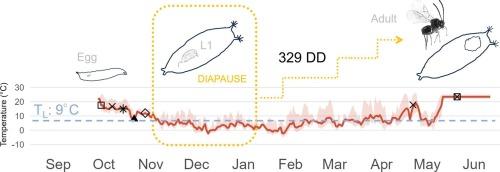苏氏果蝇生物防治剂Ganaspis kimorum越冬策略的研究
IF 3.4
2区 农林科学
Q2 BIOTECHNOLOGY & APPLIED MICROBIOLOGY
引用次数: 0
摘要
寄生蜂幼虫(膜翅目:蝇科)是苏氏果蝇(双翅目:果蝇科)的典型生物防治剂。本研究在瑞士和意大利北部的野外条件下,研究了金毛鼠的越冬策略。从2021年到2024年,在七个不同气候的地点进行了实地试验,将G. kimorum暴露在自然变化的温度下。结果表明,温度可能介导了滞育的诱导,9月下旬后暴露可成功触发滞育。解剖发现,滞育发生在铃木氏夜蛾蛹期早期的早期幼虫期(L1)。在7个地点中的4个,金氏巨蝽能够在冬季生存下来,并长成成虫。不同部位的存活率差异显著(0.4 - 17.6%)。分析显示,温度低于0°C和高于30°C的天数与昆虫存活率呈显著负相关。通过对成虫羽化前所需度数变化的分析,证实了kimorum在一龄幼虫阶段发育迟缓,并提出了较低的温度阈值为9°C,滞育后需要329±6度数才能发育到成虫阶段。本研究为该寄生蜂的生物学特性研究提供了有价值的见解,可为优化田间放放量和提高该寄生蜂的生物防治效果提供参考。本文章由计算机程序翻译,如有差异,请以英文原文为准。

Investigating the overwintering strategy of Ganaspis kimorum, a biological control agent of Drosophila suzukii
The larval parasitoid Ganaspis kimorum Buffington (Hymenoptera: Figitidae) is a classical biological control agent of Drosophila suzukii (Matsumura) (Diptera: Drosophilidae). This study investigated the overwintering strategy of G. kimorum under field conditions in Switzerland and Northern Italy. Field experiments conducted from 2021 to 2024 involved exposing G. kimorum to naturally variable temperatures in seven sites with different climates. Results indicate that diapause induction may be mediated by temperature, with exposures after late September successfully triggering diapause. Dissections revealed that diapause occurs in the early larval instar (L1) residing within early pupal stages of D. suzukii. In four out of seven sites, G. kimorum was able to survive winter conditions and emerged as adult. Survival rates varied significantly across sites (0.4–17.6 %). The analysis revealed significant negative associations between insect survival and the count of days with temperatures below 0°C and above 30°C. Analysing the variation of Degree Days needed until adult emergence confirmed that G. kimorum arrests its development as a first-instar larva and suggests a lower thermal threshold of 9°C, with 329 ± 6 post-diapause Degree Days needed to develop to the adult stage. The study provides valuable insights into the biology of the parasitoid that may be helpful for optimizing field releases and enhancing the effectiveness of G. kimorum as a biological control agent of D. suzukii.
求助全文
通过发布文献求助,成功后即可免费获取论文全文。
去求助
来源期刊

Biological Control
生物-昆虫学
CiteScore
7.40
自引率
7.10%
发文量
220
审稿时长
63 days
期刊介绍:
Biological control is an environmentally sound and effective means of reducing or mitigating pests and pest effects through the use of natural enemies. The aim of Biological Control is to promote this science and technology through publication of original research articles and reviews of research and theory. The journal devotes a section to reports on biotechnologies dealing with the elucidation and use of genes or gene products for the enhancement of biological control agents.
The journal encompasses biological control of viral, microbial, nematode, insect, mite, weed, and vertebrate pests in agriculture, aquatic, forest, natural resource, stored product, and urban environments. Biological control of arthropod pests of human and domestic animals is also included. Ecological, molecular, and biotechnological approaches to the understanding of biological control are welcome.
 求助内容:
求助内容: 应助结果提醒方式:
应助结果提醒方式:


